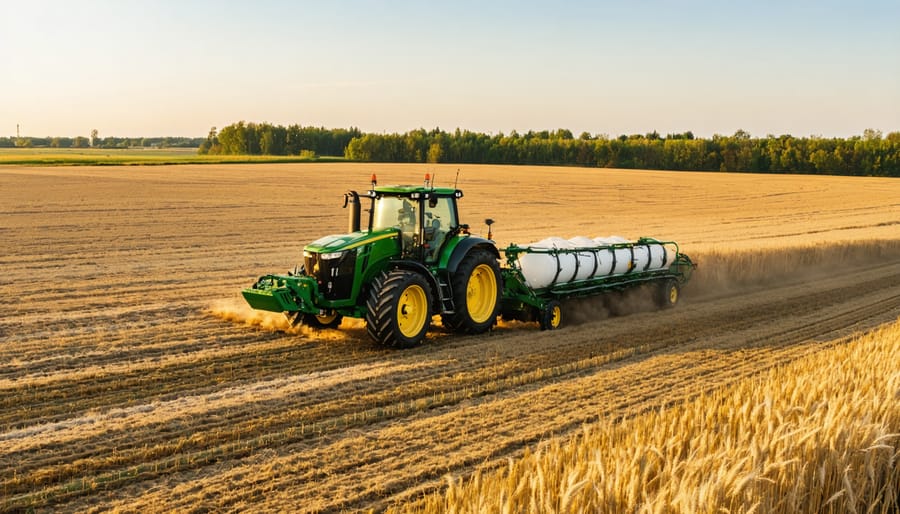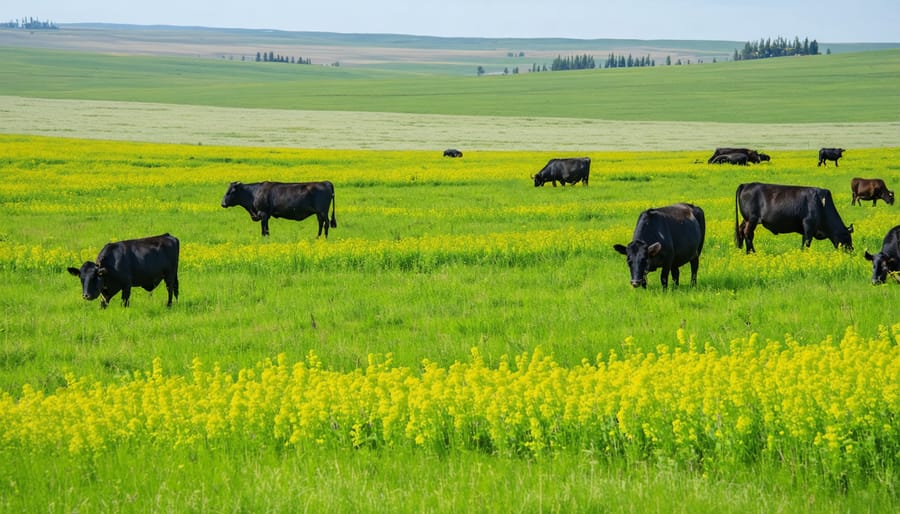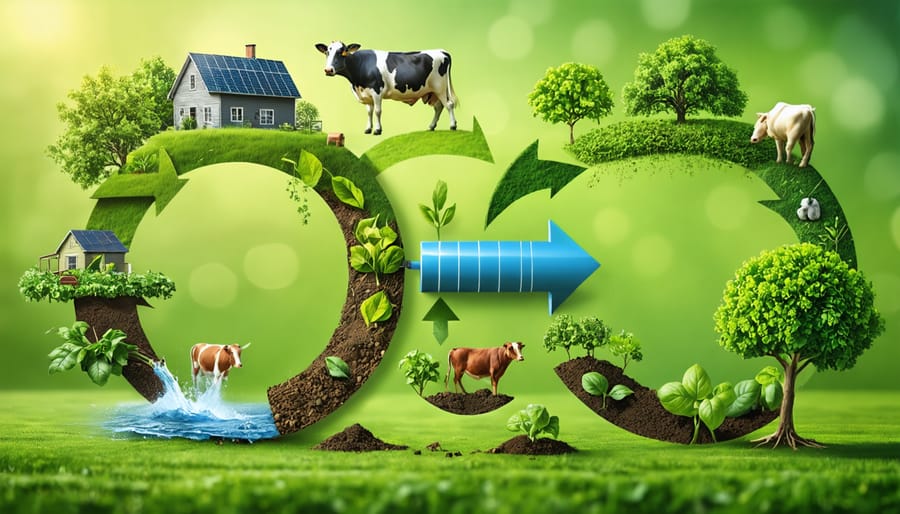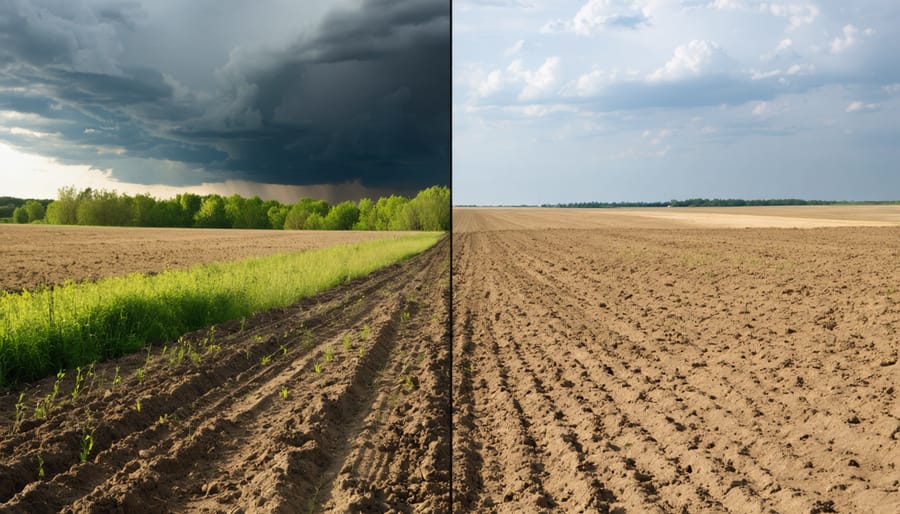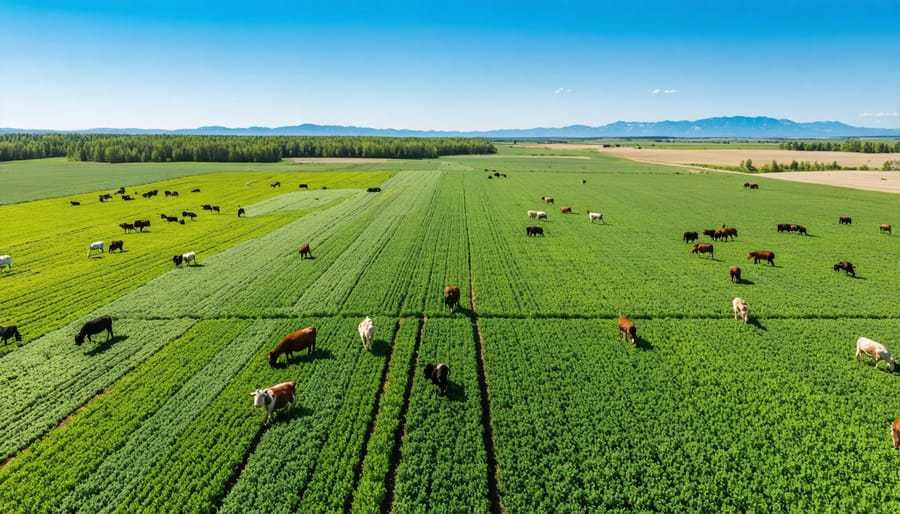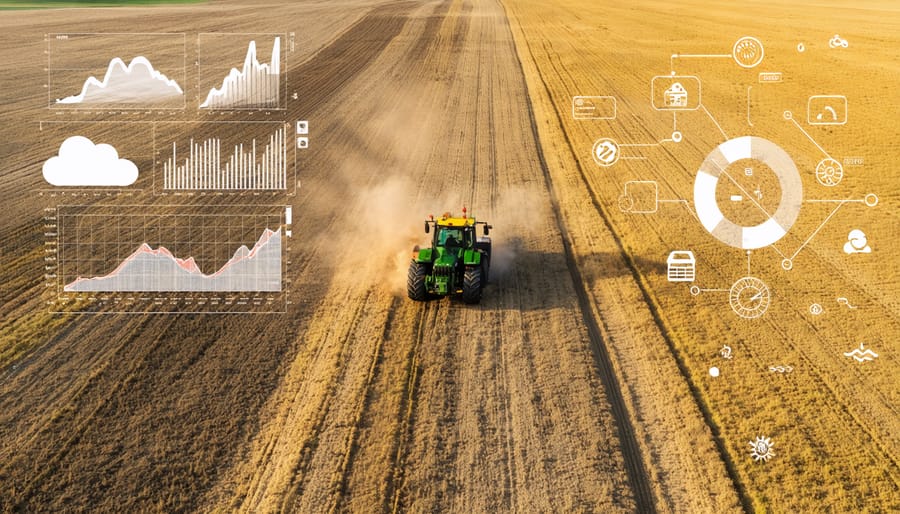**Diversify your crop rotations** to build soil resilience and reduce weather-related risks. Adding drought-tolerant pulses like lentils or chickpeas between traditional cereal crops creates natural nitrogen, improves soil structure, and provides market flexibility when extreme weather threatens single-crop operations.
**Install variable rate technology** on existing equipment to optimize water and fertilizer use based on real-field conditions. This precision approach reduces input costs by 15-30% while minimizing greenhouse gas emissions—critical as Alberta faces increasingly unpredictable precipitation patterns and stricter environmental regulations.
**Establish shelterbelts and riparian buffer zones** strategically across your operation to combat wind erosion, manage water runoff, and create microclimate benefits. Saskatchewan farmer Jim Peterson reduced topsoil loss by 40% after planting tree rows on his 2,000-hectare operation, while simultaneously increasing beneficial insect populations that control crop pests naturally.
**Adopt cover cropping systems** during traditional fallow periods to maintain living roots in the soil year-round. Species like winter rye or hairy vetch protect against erosion, capture excess nutrients, suppress weeds, and add organic matter—transforming fallow land from a liability into an asset that builds long-term productivity.
Climate-smart farming isn’t about abandoning proven methods—it’s about strengthening your operation’s foundation to withstand whatever weather patterns emerge. These practices deliver measurable returns while positioning Canadian farms as environmental leaders in global agriculture markets increasingly demanding sustainability credentials alongside quality products.
What Climate-Smart Farming Actually Means for Canadian Producers
Climate-smart farming isn’t another buzzword to add to your already full plate—it’s a practical framework that many Alberta producers are already using, whether they call it that or not. At its core, climate-smart farming means growing your operation’s productivity while building resilience against weather extremes and reducing your environmental footprint. Think of it as farming smarter, not harder, in a climate that’s becoming less predictable.
The approach rests on three interconnected pillars that work together rather than competing for your attention and resources.
**Productivity** means maintaining or increasing your yields and profitability despite changing conditions. For a grain farmer near Red Deer, this might look like switching to heat-tolerant canola varieties that perform better during increasingly common hot spells in July. You’re not sacrificing income to be environmentally friendly—you’re protecting your bottom line while adapting to new realities.
**Adaptation** focuses on building resilience into your operation so you can weather whatever comes next, whether that’s spring floods, summer drought, or unexpected frost events. A cattle producer near Lethbridge shared how diversifying forage species and creating dugouts in multiple locations helped his operation survive the 2021 drought that devastated neighbors who relied on single water sources. These aren’t radical changes—they’re strategic adjustments that reduce vulnerability.
**Mitigation** involves reducing greenhouse gas emissions and capturing carbon where possible. Before you roll your eyes, remember this pillar often saves money too. Reduced tillage practices not only store carbon in your soil but cut fuel costs significantly. One Lacombe-area farmer calculated savings of $15 per acre annually on diesel alone after switching to no-till—while improving soil health and water retention.
What makes this framework powerful is how these pillars reinforce each other. Cover crops (adaptation) improve soil moisture retention during dry spells, increase organic matter that stores carbon (mitigation), and can provide additional livestock feed (productivity). You’re not choosing between profitability and sustainability—you’re finding practices that deliver both.

Why Alberta Farms Need Climate-Adaptive Strategies Now
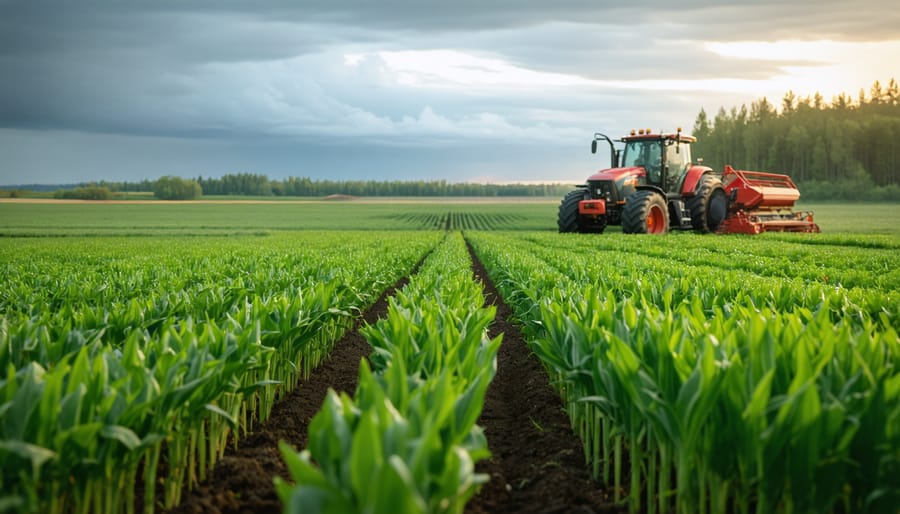
The Real Costs of Climate Unpredictability
Alberta farmers are facing financial pressures that previous generations never encountered. The 2021 heat dome event alone cost Canadian agriculture an estimated $698 million, with Alberta’s cattle and crop sectors hit particularly hard. As Tom Hendrickson, a third-generation grain farmer near Lethbridge, puts it: “We used to plan around predictable spring frost dates. Now, we’re gambling every season.”
The numbers tell a sobering story. Over the past decade, Alberta has experienced a 23% increase in extreme weather events affecting agricultural operations. Late spring frosts have pushed back planting windows by up to three weeks in some regions, while summer heatwaves exceeding 35°C have reduced canola yields by 15-20% in affected areas. These aren’t isolated incidents—they’re becoming the new normal.
Water scarcity presents another mounting challenge. Southern Alberta irrigation districts have implemented water rationing in four of the last seven years, forcing difficult decisions about which crops get priority. The result? Reduced income potential and increased operational complexity. Many producers report spending an additional 10-15 hours weekly just managing weather-related uncertainties—time that could be invested in productive farm activities.
The ripple effects extend beyond immediate crop losses. Equipment purchased for traditional timelines sits idle during delayed planting seasons. Labour contracts become harder to manage with unpredictable harvest windows. Insurance premiums have climbed 18% on average since 2019, reflecting the industry’s recognition of climate volatility.
Perhaps most concerning is the impact on long-term planning. When you can’t predict basic growing conditions, investing in infrastructure, selecting crop varieties, or even securing operating loans becomes increasingly complicated. Climate unpredictability isn’t just an environmental issue—it’s an economic one that demands practical, adaptive responses.
The Economic Opportunity in Going Climate-Smart
Climate-smart farming isn’t just good for the planet—it’s increasingly good for your bottom line. Across Alberta, farmers who’ve adopted these practices are discovering multiple revenue streams and cost savings that strengthen their operations year after year.
Let’s start with input costs. Many Alberta producers report fertilizer savings of 15-30% after transitioning to precision agriculture and variable rate application. That’s significant money back in your pocket each season. Cover cropping and improved soil health reduce dependency on synthetic inputs while building natural fertility that compounds over time.
Carbon markets represent a growing opportunity for Canadian farmers. Programs like the Alberta Emission Offset System now pay producers for practices like reduced tillage and improved nitrogen management. Early adopters are earning $15-40 per acre annually, with some operations generating $20,000-50,000 in carbon credit revenue. These payments reward you for stewardship practices that also improve your soil.
Premium markets are expanding rapidly too. Canadian consumers increasingly seek out sustainably-grown products, and export markets—particularly in Europe and Asia—pay premiums for verified climate-smart commodities. Some Alberta grain farmers have secured contracts 10-15% above conventional rates.
Perhaps most importantly, climate-smart practices build resilience. During Alberta’s 2021 drought, producers with diverse crop rotations and improved soil organic matter maintained yields while neighbors struggled. This operational stability protects your long-term investment, reducing risk from increasingly variable weather patterns. The upfront transition costs become insurance against an uncertain future—while generating immediate savings and new revenue opportunities.
Proven Climate-Smart Practices That Work on Canadian Soil
Building Soil Health as Your First Line of Defense
Healthy soil forms the foundation of any climate-resilient farm. When you invest in building soil health, you’re not just improving this season’s crop—you’re creating a living system that naturally withstands drought, absorbs excess moisture, and captures carbon from the atmosphere.
**Cover Crops: Your Year-Round Soil Protection**
Cover crops like winter rye, clover, and hairy vetch keep your soil covered during vulnerable periods. According to a 2022 study from Lacombe Research and Development Centre, cover cropping increased soil organic matter by 0.8% over three years and improved water infiltration rates by 35%. This means during heavy rainfall events—increasingly common in Alberta—your fields can absorb an additional 25-40 millimetres of water per hour, reducing runoff and erosion.
**Reduced Tillage: Preserving Soil Structure**
Transitioning to reduced or no-till practices protects the soil structure that took years to build. Trevor Johnson, a grain farmer near Lethbridge, reduced his tillage passes from five to one in 2018. “Our soil now holds moisture 3-4 weeks longer than conventionally tilled neighbours,” he reports. “During the 2021 drought, that extra water retention saved our crop.”
**Composting and Organic Amendments**
Adding composted manure or other organic amendments boosts both soil fertility and carbon storage. Applications of 10-15 tonnes per hectare can increase soil carbon by 0.5-1.0 tonnes annually while improving nutrient availability. These soil regeneration practices work together synergistically—cover crops feed soil microbes, reduced tillage protects their habitat, and organic amendments provide the raw materials for building resilient soil structure that withstands whatever weather patterns come your way.
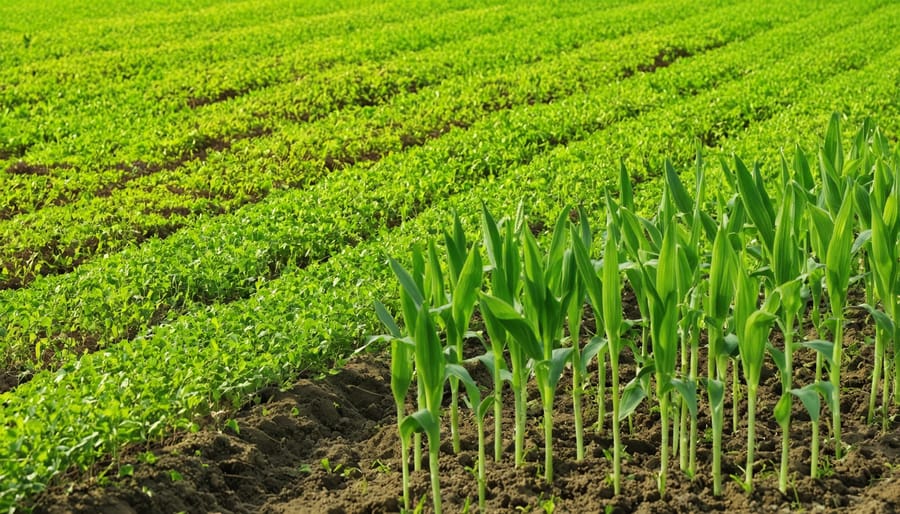
Water Management That Adapts to Extremes
Water availability in Alberta has become increasingly unpredictable, with drought conditions one season and excess rainfall the next. Smart water management isn’t optional anymore—it’s essential for farm survival and profitability.
**Start with What You Have**
The most cost-effective first step is measuring current water use. Soil moisture sensors (starting around $300-500 for basic systems) provide real-time data that prevents both under and over-watering. Several Alberta farmers report 20-30% water savings simply by switching from scheduled to sensor-based irrigation.
Rainwater harvesting offers another practical entry point. A 1,000-square-meter barn roof can capture approximately 600,000 litres annually based on Alberta’s average precipitation. Basic collection systems start at $2,000-3,000, with provincial grants sometimes available to offset costs.
**Irrigation Efficiency Upgrades**
Transitioning from flood irrigation to drip or pivot systems represents a larger investment ($15,000-50,000 depending on acreage) but can reduce water consumption by 40-60%. The Irrigation Efficiency Program through Results Driven Agriculture Research has helped numerous Alberta operations make this transition with technical support and cost-share opportunities.
Consider variable rate irrigation technology that adjusts water application based on field zones. Southern Alberta grain farmer Tom Henderson reduced his water use by 35% while maintaining yields after installing zone-controlled pivots.
**Drought-Resistant Varieties**
Seed selection matters tremendously. Universities of Alberta and Saskatchewan have developed drought-tolerant varieties of wheat, barley, and canola specifically adapted to Prairie conditions. These varieties typically cost 10-15% more but provide insurance against dry spells without sacrificing quality when moisture is adequate.
**Building Resilience**
Comprehensive water management strategies combine multiple approaches rather than relying on single solutions, creating redundancy that protects against whatever weather arrives.
Diversification Strategies That Spread Your Risk
Putting all your resources into a single crop is like betting your entire operation on one hand of cards. Climate-smart farming means spreading your risk across multiple strategies that work together to protect your bottom line.
**Crop rotation** remains one of the most effective tools in your resilience toolkit. By alternating crops like canola, wheat, barley, and pulse crops such as lentils or peas, you’re not just improving soil health—you’re creating insurance against unpredictable weather. When drought hits hard, your pulse crops’ deeper roots may still pull through while shallow-rooted cereals struggle. Alberta farmer James Chen from Lethbridge found that rotating between cereals and nitrogen-fixing pulses reduced his fertilizer costs by 30% while maintaining yields even during the 2021 drought.
Integrated livestock systems offer another layer of protection. Combining cattle with crop production creates multiple income streams while improving land productivity. Your livestock converts crop residues into valuable manure, reducing fertilizer expenses and building soil organic matter that helps retain moisture during dry spells.
**Agroforestry** practices, like establishing shelterbelts or alley cropping systems, provide windbreaks that reduce soil erosion and create microclimates protecting crops from temperature extremes. These trees also generate additional revenue through timber or fruit production.
**Polyculture approaches**—growing multiple crop species together—may seem unconventional, but they’re gaining traction among progressive Alberta farmers. Intercropping cereals with legumes or establishing diverse pasture mixes creates ecosystems that naturally resist pests and diseases while maintaining productivity across varying weather conditions. The key is starting small with one diversification strategy, measuring results, and gradually expanding what works for your specific operation.
Precision Agriculture Tools That Make Adaptation Easier
Climate adaptation doesn’t require a complete technology overhaul. Today’s precision agriculture tools are more accessible and user-friendly than ever, helping Alberta farmers make informed decisions without the complexity.
Start with weather stations—compact units that track temperature, precipitation, humidity, and wind patterns specific to your field. These devices cost between $300-$2,000 and provide hyperlocal forecasts that beat generic regional predictions. Red Deer farmer James Kowalski credits his weather station with preventing $15,000 in crop losses by alerting him to an unexpected frost event.
Soil moisture sensors take the guesswork out of irrigation timing. These affordable tools (starting around $200) measure water content at various depths, ensuring you irrigate only when necessary—conserving water while maintaining crop health.
Farm management software consolidates this data into actionable insights. Many programs offer free basic versions and integrate seamlessly with existing equipment. They track planting dates, input costs, yield variations, and weather patterns, creating a comprehensive picture that helps you spot trends and adjust strategies.
The key is starting small—choose one tool that addresses your most pressing climate challenge, master it, then expand your toolkit as confidence grows.
Carbon Farming: Turning Emissions into Income
Canadian farmers are discovering that capturing carbon isn’t just good for the planet—it can also generate new revenue streams. Carbon sequestration practices like planting shelterbelts, restoring grasslands, and incorporating biochar into soil actively remove CO₂ from the atmosphere while improving farm productivity.
Shelterbelts reduce wind erosion and create wildlife habitat while sequestering approximately 2-3 tonnes of carbon per hectare annually. Restoring marginal cropland to perennial grassland can lock away 0.5-1.5 tonnes of carbon per hectare each year, while also reducing input costs. Biochar—charcoal created from agricultural waste—can sequester carbon for centuries when added to soil, simultaneously improving water retention and nutrient availability.
Alberta farmers can access carbon credit programs through several pathways. The Alberta Emission Offset System allows producers to earn credits for eligible practices, while private marketplace platforms like Nori and Indigo Ag connect farmers directly with buyers. Agriculture and Agri-Food Canada’s Agricultural Climate Solutions program provides funding to support adoption of these practices.
“We enrolled 80 hectares in a carbon program after restoring it to native grassland,” shares Tom Henderson, a central Alberta producer. “The annual carbon payments help offset our land costs while the restored ecosystem supports our cattle operation naturally.”
Start by conducting a carbon audit to identify your farm’s sequestration potential, then work with an agrologist familiar with carbon protocols to develop a plan that fits your operation.
Real Alberta Farmers Share Their Climate-Smart Success Stories
When it comes to climate-smart farming, real results from your neighbours speak louder than theory. Here are three Alberta farmers who’ve successfully adapted their operations to meet climate challenges head-on.
**Tom and Sarah Brennan – Mixed Farm near Vermilion**
The Brennans run a 1,200-hectare operation combining cattle and grain. Like many Alberta producers, they faced increasingly unpredictable rainfall patterns that wreaked havoc on their spring seeding windows and summer forage production.
Their solution? A comprehensive water management overhaul. They installed 12 solar-powered dugouts across their property and implemented rotational grazing on 400 hectares of pastureland. “We divided our pastures into smaller paddocks and started moving cattle every three days,” Tom explains. “It gave the grass time to recover and improved water infiltration dramatically.”
The results have been remarkable. After three years, the Brennans report 35% improvement in soil moisture retention and a 28% increase in forage production per hectare. Their cattle operation now maintains productivity even during dry spells that previously would have forced early selling. Feed costs dropped by $18,000 annually, and soil organic matter increased from 3.2% to 4.1%.
Tom’s advice? “Start small. We began with one quarter-section and expanded once we saw results. Don’t try to transform your entire operation overnight.”
**Marcus Chen – Grain Operation near Lethbridge**
Marcus manages 800 hectares of wheat, canola, and pulse crops in southern Alberta. Extended drought periods and increased wind erosion threatened both his topsoil and yields.
He adopted a no-till system combined with cover cropping between cash crops. “I was skeptical about cover crops initially,” Marcus admits. “The seed cost worried me. But after talking with agronomists and seeing Alberta farmers’ success stories, I committed to trying it on 160 hectares.”
Marcus planted fall rye and hairy vetch after wheat harvest, terminating them before spring seeding. Within two seasons, he documented measurable improvements: wind erosion reduced by 65%, soil temperature moderation during heat events, and wheat yields increasing by 8 bushels per hectare.
“The cover crops act like a blanket,” he says. “They protect soil, feed beneficial microbes, and break up compaction. My fertilizer costs dropped 15% because the system became more efficient.”
**The Kowalski Family – Vegetable Farm near Lacombe**
Operating 40 hectares of market vegetables, the Kowalskis struggled with intense rainfall events that caused flooding and disease pressure.
They invested in improved drainage infrastructure and high tunnels for season extension. Jennifer Kowalski explains: “We installed 600 metres of subsurface drainage tiles and built four 30-metre high tunnels. The combination protected crops from both excess water and late spring frosts.”
The tunnels extended their growing season by six weeks, allowing earlier planting and later harvests. Disease pressure from excess moisture decreased by 40%, reducing fungicide applications. Revenue increased 32% in year two through expanded production windows.
“Climate adaptation isn’t just defensive,” Jennifer notes. “It opens new opportunities. We now grow heat-loving crops like peppers that weren’t reliable before.”
These farmers demonstrate that climate-smart strategies deliver tangible benefits. Their experiences prove that thoughtful adaptation improves both resilience and profitability across diverse Alberta operations.
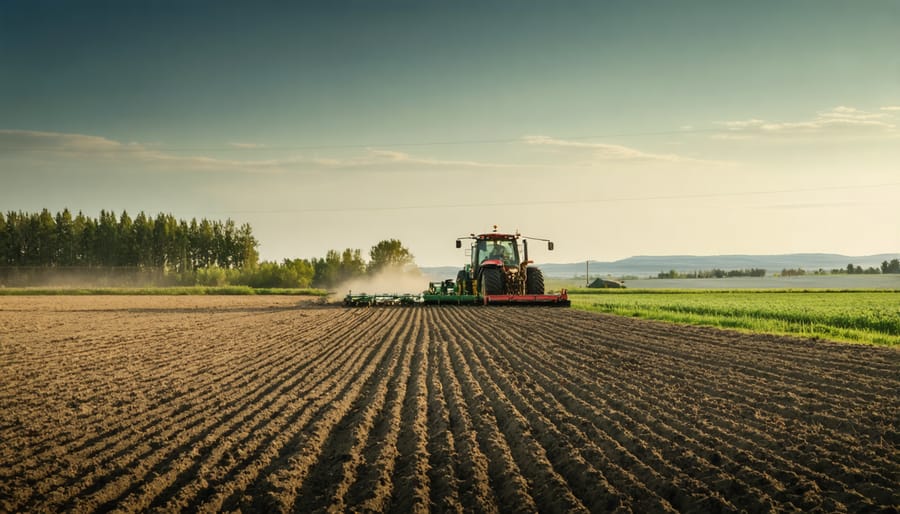
Getting Started: Your Climate-Smart Transition Plan
Assess Your Farm’s Climate Vulnerabilities
Understanding your farm’s specific climate vulnerabilities is the foundation of effective climate-smart planning. Start by examining historical weather patterns on your land over the past decade. Have you noticed shifts in frost dates, increased precipitation variability, or more frequent extreme heat events? Alberta producers are experiencing these changes differently depending on their region—southern operations face intensifying drought conditions, while northern farms contend with unpredictable spring thaws.
Ask yourself these key questions: Which climate events have caused the most significant crop or livestock losses in recent years? Do you have adequate water storage for extended dry periods? Are your buildings and infrastructure equipped to handle heavier snow loads or wind events? What’s your soil’s current capacity to absorb and retain moisture during both drought and flood conditions?
Consider your operation’s specific exposure. Grain farmers should evaluate heat stress risks during critical pollination windows, while livestock producers need to assess pasture resilience and animal heat stress vulnerabilities. Specialty crop growers face unique timing sensitivities around late spring frosts.
Document these observations and discuss them with your agrologist or local agricultural extension office. Many Alberta producers have found value in participating in community risk assessments, sharing experiences with neighbours facing similar challenges. This collaborative approach helps identify regional patterns and potential solutions you might not discover alone.
Start Small: Low-Cost, High-Impact First Steps
Starting your climate-smart journey doesn’t require a complete farm overhaul or significant capital investment. Begin with soil health testing—many Alberta agricultural offices offer this service at minimal cost, providing baseline data to guide your decisions. “We started by simply testing our fields and adjusting fertilizer applications based on actual nutrient needs rather than habit,” explains Mark Davidson, a central Alberta grain farmer. “That first year, we reduced input costs by 18% while maintaining yields.”
Cover cropping represents another accessible entry point. Plant a simple mix of oats and peas after harvest to protect soil through winter and add organic matter. The investment is modest—typically $25-40 per acre—and Alberta producers report reduced erosion and improved water infiltration within a single season.
Consider adjusting your seeding dates slightly to avoid peak heat stress periods, a zero-cost adaptation that several Lethbridge-area farmers credit with protecting yields during recent drought years. Similarly, reviewing and repairing irrigation systems for leaks can save thousands of litres of water annually at little expense.
These small changes generate measurable results—lower input costs, improved soil structure, better moisture retention—building confidence and financial capacity for larger climate-adaptive investments down the road.
Funding and Support Available to Canadian Farmers
Canadian farmers have access to substantial funding opportunities designed to support the transition to climate-smart practices. At the federal level, Agriculture and Agri-Food Canada offers the Canadian Agricultural Partnership (CAP) programs, which provide cost-share funding for beneficial management practices like cover cropping, rotational grazing systems, and precision agriculture equipment. The On-Farm Climate Action Fund specifically targets emissions reduction initiatives, offering up to $100,000 per farm for nitrogen management and cover cropping projects.
Alberta farmers benefit from additional provincial support through Alberta Agriculture and Irrigation’s Environmental Stewardship and Climate Change program. This initiative provides technical assistance and financial incentives for water management improvements, soil health projects, and renewable energy installations. Many producers have successfully accessed these funds to install variable-rate technology and transition to regenerative practices.
Local agricultural fieldmen and agronomists offer free consultations to help navigate funding applications and develop farm-specific climate adaptation plans. The Alberta Conservation Association and various commodity groups also provide workshops and peer-learning opportunities where farmers share practical experiences implementing climate-smart strategies. Don’t hesitate to reach out—most successful applicants emphasize that connecting with local support networks made the funding process manageable and helped them identify opportunities they hadn’t initially considered.
Expert Insights: Building Long-Term Farm Sustainability
We spoke with leading experts across Canada to gather perspectives on what climate-smart farming truly means for the future of agriculture. Their insights offer both practical wisdom and encouragement for farmers navigating this transition.
**Dr. Sarah Chen, Soil Scientist at the University of Alberta**, emphasizes that farmers are already climate innovators: “Alberta producers have been adapting to variable weather for generations. What we’re seeing now is that same innovative spirit applied with better data and tools. The farmers implementing cover cropping and reduced tillage aren’t just protecting their soil—they’re building resilience that will serve their operations for decades.”
Dr. Chen addresses a common concern about upfront costs: “Start small. Even converting 10% of your acres to regenerative practices creates a learning laboratory. Many producers see measurable soil health improvements within three growing seasons, which translates directly to reduced input costs and better drought resilience.”
**James Lockhart, Climate Adaptation Specialist with Agriculture and Agri-Food Canada**, sees tremendous momentum building: “We’re at a tipping point where climate-smart practices are becoming the norm rather than the exception. The data from farms across the Prairies shows that diversified crop rotations combined with precision agriculture can maintain yields while cutting fertilizer use by 15-20%. That’s significant both economically and environmentally.”
Lockhart offers encouragement to farmers feeling overwhelmed: “You don’t need to transform your entire operation overnight. Focus on one practice that addresses your biggest challenge—whether that’s water management, soil erosion, or input costs. Build from there.”
**Maria Kowalski, fourth-generation Alberta farmer and agricultural consultant**, brings a producer’s perspective: “I was skeptical about some of these practices until I saw my neighbour’s fields staying green two weeks longer during the 2021 drought. He’d been building soil organic matter for five years through cover crops and compost applications. That convinced me more than any research paper could.”
Her advice to fellow farmers is direct: “Connect with other producers who are trying these methods. The peer-to-peer learning networks across Alberta have been invaluable. We’re all figuring this out together, and there’s no shame in asking questions or admitting when something doesn’t work on your land.”
These experts agree on one fundamental point: climate-smart farming isn’t about perfection—it’s about progress, adaptation, and community support.
Climate-smart farming isn’t just about protecting our environment—it’s about securing the future of your farm. As we’ve explored throughout this article, the practices that help us adapt to climate change are the same ones that strengthen farm resilience, improve soil health, and ultimately boost your bottom line. From reduced input costs through improved soil fertility to new revenue streams from carbon programs, the economic case for climate-smart agriculture continues to grow stronger.
The beauty of this approach lies in its flexibility. Whether you’re managing 100 acres or 10,000, whether you’re focused on grain production or diversified operations, there are climate-smart strategies that fit your context. Start small if you need to—even adopting one or two practices can set you on a path toward greater sustainability and profitability.
But you don’t have to navigate this transition alone. The strongest asset in Canadian agriculture has always been our farming community. Connect with your neighbours who are already implementing these practices. Join local producer groups where knowledge-sharing happens naturally over coffee. Attend field days where you can see climate-smart techniques in action on farms similar to yours.
Ready to take your next step? Organic Farming, The Canadian Way offers workshops specifically designed for Alberta farmers exploring climate-adaptive strategies. Our support programs connect you with experienced mentors who understand the unique challenges of farming in our region. Visit our website to explore upcoming educational opportunities, access our library of Canadian case studies, and connect with agricultural professionals who can provide personalized guidance for your operation.
The climate is changing, but so is our capacity to adapt. By embracing climate-smart farming today, you’re not just responding to challenges—you’re positioning your farm to thrive for generations to come. Let’s build that future together.

